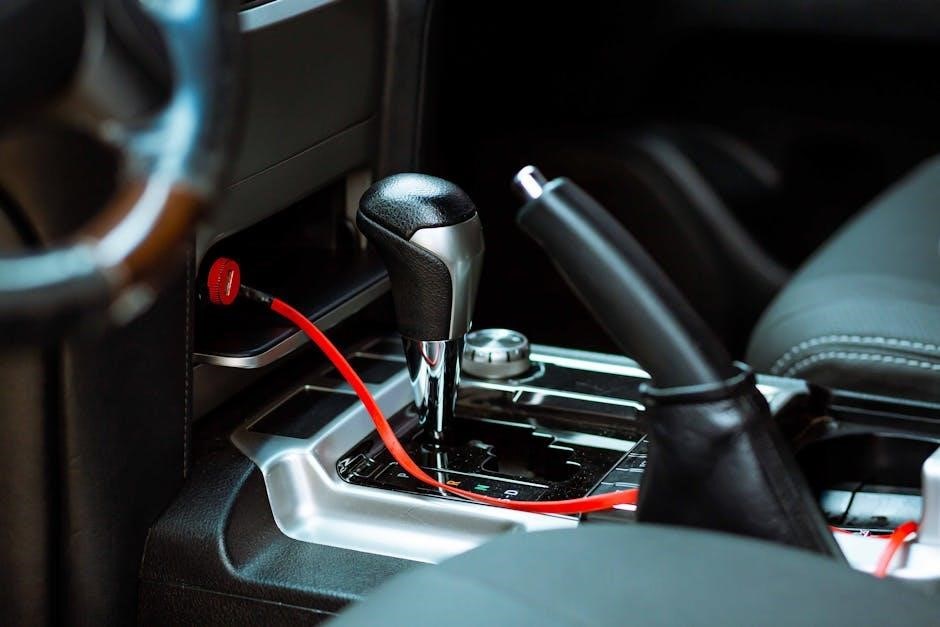The G35 transmission is a sophisticated component designed for high-performance vehicles, offering smooth gear shifts and enhanced driving experiences. Its manual variant provides drivers with precise control, making it a popular choice among enthusiasts. With advanced features and durability, the G35 transmission manual is a comprehensive guide for maintenance, troubleshooting, and optimal performance.

Overview of the G35 Transmission
The G35 transmission is a high-performance, rear-wheel-drive gearbox designed for smooth shifting and optimal power delivery. It features advanced gear ratios, robust construction, and compatibility with various engine configurations, ensuring reliability and efficiency.

History and Development

The G35 transmission has a rich history rooted in innovative engineering and precision manufacturing. Developed to meet the demands of high-performance vehicles, it was designed to deliver smooth, responsive gear shifts and optimal power delivery. The transmission’s development involved extensive research and testing, leveraging advanced technologies to ensure durability and reliability. Its creation was influenced by feedback from drivers and technicians, focusing on improving both performance and user experience. Over the years, the G35 transmission has undergone continuous refinement, with updates aimed at enhancing its compatibility with various engine configurations and driving conditions. This evolution has solidified its reputation as a trusted component in the automotive industry, particularly among enthusiasts who value manual control and precision. The G35 transmission’s history reflects a commitment to excellence, making it a cornerstone of modern automotive design.
Key Features and Benefits
The G35 transmission manual is renowned for its advanced engineering and robust design, offering drivers unparalleled control and performance. One of its standout features is its smooth and precise gear shifting, which enhances the overall driving experience. The transmission is built with high-quality materials, ensuring durability and longevity even under rigorous conditions. It also boasts excellent compatibility with a variety of engine configurations, making it a versatile choice for different vehicle setups. Another key benefit is its ability to handle high torque outputs, providing consistent power delivery during acceleration. Additionally, the G35 transmission manual is designed with ease of maintenance in mind, featuring accessible components and clear service intervals. Its compact design further contributes to efficient installation and reduced weight, improving the vehicle’s overall agility. These features make the G35 transmission manual a preferred option for both enthusiasts and professionals seeking reliability and peak performance.
Types of G35 Transmissions
The G35 transmission is available in several configurations to cater to different driving preferences and vehicle requirements; The most common type is the 6-speed manual transmission, which is highly praised for its smooth shifting and precise control. This model is particularly popular among driving enthusiasts due to its engaging and responsive nature. Additionally, there is a 5-speed manual transmission option, which offers slightly different gear ratios and is often preferred for its simplicity and durability. Both manual transmissions are known for their robust construction and ability to handle high torque outputs, making them suitable for performance-oriented vehicles. Furthermore, the G35 transmission is also available in automatic variants, though the manual versions remain the most sought-after for their driver-centric design. Each type is engineered to deliver optimal performance, ensuring a seamless driving experience tailored to specific needs.
Installation Guide
The G35 transmission manual provides a comprehensive guide for installing the transmission, ensuring a smooth and efficient process. It outlines essential tools, step-by-step instructions, and tips to avoid common mistakes during installation.
Step-by-Step Installation Process

Installing the G35 transmission requires careful preparation and adherence to a structured process. Begin by gathering all necessary tools and equipment, ensuring compatibility with your vehicle’s specifications. Consult the manual for specific torque values and alignment guidelines. Start by disconnecting the battery and draining the transmission fluid. Next, remove the old transmission, taking care to support the vehicle securely. Inspect the new transmission for any damage or defects before installation. Mount the new unit, ensuring proper alignment with the engine and drivetrain. Reconnect all electrical and hydraulic components, following the sequence outlined in the manual. Refill the transmission fluid to the recommended level and bleed the system to remove air bubbles. Finally, test the transmission by driving in a controlled environment, checking for smooth gear shifts and proper function. Always follow safety protocols and refer to the manual for detailed instructions.
Essential Tools and Equipment
Installing or servicing the G35 transmission requires a set of specialized tools to ensure accuracy and safety. A transmission jack is crucial for lifting and positioning the unit securely. A socket set, including a 32 mm socket for the transmission bolts, is essential. Torque wrenches are necessary for precise bolt tightening, adhering to the manufacturer’s specifications. A drain pan is needed for fluid changes, while a fluid pump ensures proper filling. A set of wrenches, including adjustable and impact wrenches, will help with various connections. Pliers and punches are useful for smaller components. Safety equipment, such as gloves and safety glasses, is vital to protect against injuries. A service manual provides detailed instructions and diagrams, while a diagnostic tool helps identify issues. Proper alignment tools, like a transmission alignment kit, ensure correct installation. Finally, a hydraulic press may be required for specific repairs. Having these tools ready ensures a smooth and efficient process.
Common Mistakes to Avoid
When working with the G35 transmission, several common mistakes can lead to costly repairs or compromised performance. One of the most frequent errors is improper alignment during installation, which can cause gear wear and misalignment issues. Another mistake is using the wrong transmission fluid, as specified in the manual, which can degrade internal components over time. Over-tightening or under-tightening bolts is another pitfall, as it can lead to leaks or structural damage. Additionally, neglecting to follow the torque specifications outlined in the manual can result in premature wear or failure of critical parts. Many enthusiasts also overlook the importance of proper tools, such as a transmission jack, which is essential for safe and accurate installation. Finally, ignoring the recommended maintenance schedule can lead to unexpected breakdowns and higher repair costs. By avoiding these common mistakes, you can ensure the longevity and optimal performance of your G35 transmission.
Proper Alignment Techniques

Proper alignment is crucial when installing or servicing the G35 transmission to ensure smooth operation and prevent premature wear. Start by ensuring the transmission is perfectly level during installation, as any tilt can lead to uneven gear wear. Use shims or spacers as specified in the manual to achieve accurate alignment with the engine and drivetrain. Misalignment can cause vibration, noise, and reduced performance. Always use a dial indicator to check the transmission’s position relative to the engine, ensuring the input shaft aligns correctly with the clutch or torque converter. Additionally, verify that the drivetrain components, such as the driveshaft and differential, are properly aligned to avoid stress on the transmission. Failure to align these components can result in costly repairs. By following these alignment techniques, you can ensure optimal performance, reduce wear, and extend the lifespan of your G35 transmission.
Torque Specifications
Torque specifications are critical when working with the G35 transmission to ensure proper assembly and prevent damage. Always refer to the manufacturer’s manual for precise torque values, as they vary depending on the component. For example, the transmission pan bolts typically require 10-12 ft-lbs of torque, while the bellhousing bolts may need 30-35 ft-lbs. Over-tightening can damage threads or strip bolts, while under-tightening may lead to leaks or loose connections. Use a torque wrench to apply the specified values in a star pattern to ensure even sealing and avoid warping surfaces. Pay special attention to the driveshaft and differential connections, as improper torque can lead to vibration or premature wear. Always double-check the torque specifications for each component to maintain the integrity of the transmission and ensure reliable performance. Proper torque application is essential for longevity and optimal functionality of the G35 transmission.
Maintenance Schedule
Regular maintenance is essential for the G35 transmission’s longevity. Schedule fluid checks every 30,000 miles, replace the filter annually, and inspect for wear; Adhering to this routine ensures smooth operation and prevents premature wear.
Recommended Maintenance Intervals
Regular maintenance is crucial for the G35 transmission’s optimal performance. Follow these intervals to ensure longevity and reliability. Every 30,000 miles, inspect the transmission fluid level and condition, and top it off if necessary. Replace the transmission filter every 60,000 miles to prevent contaminants from affecting performance. At 90,000 miles, perform a full transmission fluid flush and replace the filter again. Inspect the pan gasket for leaks and tighten the bolts if needed. Additionally, check the clutch and gear engagement at 120,000 miles for any signs of wear. Proper alignment and torque specifications should be verified during these intervals to maintain smooth operation. Adhering to these schedules ensures the G35 transmission operates efficiently and minimizes the risk of costly repairs.
Transmission Fluid Replacement
Replacing the transmission fluid in your G35 is essential for maintaining its performance and longevity. Start by gathering the necessary tools, including a drain pan, socket wrench, and new fluid filter. Warm up the engine by driving for a few minutes to ensure the fluid drains completely. Locate the transmission pan, typically found underneath the vehicle, and remove the bolts to drain the old fluid into the pan. Once drained, replace the filter and securely tighten the pan bolts. Refill the transmission with the recommended fluid type, as specified in the G35 manual. Use a funnel to prevent spills and check for leaks after refilling. Dispose of the used fluid responsibly. Proper fluid replacement ensures smooth gear transitions and prevents overheating. Always refer to the manual for specific torque specifications and fluid capacity to avoid overfilling or underfilling.
Filter Replacement Guidelines
Regular replacement of the transmission filter is crucial for maintaining the G35’s performance and preventing contamination. Start by gathering the necessary tools, including a socket wrench, drain pan, and a new filter. Locate the transmission filter, typically found near the pan, and carefully remove it by hand or with a filter wrench. Inspect the area for any residual debris and clean it thoroughly before installing the new filter. Ensure the filter is properly seated and tightened according to the manufacturer’s specifications. Dispose of the old filter responsibly, as it may contain hazardous materials. Replace the filter every 30,000 to 60,000 miles, depending on driving conditions. Always use a high-quality filter designed for your G35 to ensure optimal performance. Consult the manual for specific torque values and recommendations to avoid over-tightening, which could damage the threads. Proper filter maintenance helps extend the transmission’s lifespan and prevents costly repairs.
Inspection Checklist

A thorough inspection of the G35 transmission is essential to identify potential issues before they escalate. Start by checking the transmission fluid level and condition, ensuring it is clean and at the recommended level. Inspect the transmission pan for signs of damage, rust, or leaks. Examine the filter for debris or contamination and replace it if necessary. Check the cooler lines for any blockages or leaks, as these can affect cooling efficiency. Look for loose or damaged mounts and crossmembers, as they can cause misalignment. Inspect the driveshaft components, including the center bearing and CV joints, for wear or damage. Verify that all electrical connections, such as wiring and solenoids, are secure and functioning properly. Check the bellhousing and transmission case for any signs of damage or wear. Finally, inspect the pan gasket and vent for leaks or blockages. Regular inspections help prevent costly repairs and ensure optimal performance.

Troubleshooting Common Issues
Common G35 transmission issues include fluid leaks, erratic shifting, and unusual noises. Use diagnostic tools to identify error codes and inspect components like sensors and solenoids for malfunctions. Regular checks prevent major repairs.
Identifying Common Problems
Identifying common issues with the G35 transmission manual involves recognizing symptoms like slipping gears, delayed engagement, or unusual noises. Fluid leaks are often visible beneath the vehicle, while erratic shifting can indicate worn clutch packs or faulty solenoids. Unusual noises, such as grinding or whining, may point to damaged gears or bearings. Diagnostic tools can help pinpoint problems by reading error codes stored in the transmission control module (TCM). Common error codes include those related to sensor malfunctions or pressure inconsistencies. Regular inspections of the transmission pan, filter, and fluid levels are crucial for early detection. Additionally, visual inspections of the torque converter and gear sets can reveal wear or damage. By systematically addressing these issues, drivers can prevent minor problems from escalating into major repairs. Proper diagnostic techniques ensure accurate identification and effective troubleshooting of G35 transmission issues.
Diagnostic Tools and Techniques
Diagnosing issues with the G35 transmission manual requires a combination of advanced tools and systematic techniques; An OBD-II scanner is essential for reading error codes stored in the transmission control module (TCM), providing insights into sensor malfunctions or pressure inconsistencies. Visual inspections of the transmission pan, fluid levels, and filter can reveal signs of wear or contamination. Pressure testing tools help identify leaks or blockages in the hydraulic system, while endoscope cameras allow for internal inspections without disassembly. Advanced tools like oscilloscopes can analyze solenoid operation and clutch pack engagement. Scan tools with live data streaming enable real-time monitoring of transmission performance. By combining these tools with a thorough understanding of the transmission’s operation, technicians can accurately diagnose and address problems. Regular use of these diagnostic techniques ensures early detection of issues, preventing costly repairs and maintaining optimal performance.

Understanding Error Codes
Understanding error codes is crucial for diagnosing issues in the G35 transmission manual. These codes, often retrieved using an OBD-II scanner, provide specific insights into transmission-related problems. Common codes like P0700 (Transmission Control System Malfunction) or P0750 (Shift Solenoid A Malfunction) indicate issues with solenoids or pressure control. Each code corresponds to a particular fault, such as faulty sensors, solenoid failures, or hydraulic system malfunctions. By referencing the service manual, technicians can interpret these codes accurately. Advanced tools like scan tools with live data streaming can also monitor transmission performance in real time. Ignoring error codes can lead to severe damage, so prompt action is essential. Regular checks and updates to the transmission control module (TCM) ensure optimal performance and prevent recurring issues. Understanding these codes is the first step toward effective troubleshooting and maintenance of the G35 transmission manual.
Clutch and Gear Issues
Clutch and gear issues in the G35 transmission manual are common problems that can arise due to wear and tear or improper maintenance. Symptoms often include slipping gears, abnormal noises, or difficulty shifting. Worn clutch packs or damaged gear teeth can lead to poor engagement and reduced performance. Misalignment during installation or excessive heat from aggressive driving can exacerbate these issues. Transmission fluid contamination is another culprit, as debris can damage clutch plates and gears over time. Regular inspection of the clutch and gear components is essential to identify early signs of wear. Replacing worn parts promptly can prevent further damage to the transmission. Proper alignment techniques during installation and maintaining the correct transmission fluid levels are critical to avoiding these issues. Diagnostic tools can help pinpoint specific problems, ensuring timely repairs and maintaining the transmission’s optimal performance. Addressing clutch and gear issues early is vital to extending the lifespan of the G35 transmission manual.

Repair and Replacement
Repairing or replacing the G35 transmission involves disassembling the unit to identify and replace damaged components. Proper tools and torque specifications are essential for reassembly. Regular maintenance can prevent major repairs and extend lifespan.
Disassembly Process
The disassembly of the G35 transmission requires careful planning and precision to avoid damaging internal components. Begin by draining the transmission fluid and removing the transmission from the vehicle. Next, disconnect the electrical connectors and remove the mounting brackets. Use specialized tools to remove the bellhousing bolts and carefully pull the transmission apart. The gearset, bearings, and clutch pack can then be accessed for inspection or replacement. It is crucial to label all connectors and components to ensure proper reassembly. During disassembly, pay close attention to the alignment of gears and shafts, as improper handling can lead to costly repairs. Always refer to the G35 transmission manual for specific torque specifications and reassembly guidelines. Proper disassembly is the foundation for successful repairs and ensures the transmission operates smoothly after reassembly.
Replacing Damaged Parts
Replacing damaged parts in the G35 transmission requires precision and adherence to the manufacturer’s guidelines. Begin by identifying the faulty components, such as bearings, seals, or clutch packs, using the transmission manual as a reference. Once identified, source high-quality replacement parts that meet OEM specifications to ensure optimal performance. Use specialized tools, such as a bearing press or puller, to remove and install delicate components. Clean the transmission case thoroughly before reassembly to prevent contamination. Apply a thin layer of lubricant to moving parts to reduce friction and wear. Avoid using generic or low-quality parts, as they may compromise the transmission’s durability. Properly align and secure each component to prevent misalignment, which can lead to further damage. After replacing the parts, refer to the torque specifications in the manual to ensure all bolts and fasteners are tightened correctly. This step-by-step process ensures the transmission operates smoothly and reliably after repair.
Reassembly Tips
Reassembling the G35 transmission requires careful attention to detail to ensure proper functionality. Always refer to the transmission manual for specific instructions and torque specifications. Begin by cleaning all components thoroughly to remove dirt and debris, which can cause premature wear. Use a soft cloth and mild solvent to avoid damaging surfaces. Apply a thin layer of lubricant to moving parts, such as bearings and gears, to reduce friction and prevent overheating. Ensure all seals and gaskets are properly aligned and seated to avoid leaks. When reinstalling the transmission case, use a torque wrench to tighten bolts in the specified sequence to prevent warping. Double-check the alignment of the input and output shafts before final assembly. Test the transmission in a controlled environment, such as a lift or jack stands, to ensure smooth operation before reinstalling it in the vehicle. Proper reassembly is critical for maintaining the transmission’s performance and longevity.
Cost Estimates
The cost of repairing or replacing a G35 transmission can vary widely depending on the extent of the damage and the type of repair needed. Replacement parts, such as gears, bearings, and seals, can range from $500 to $2,000, depending on the quality and source. Labor costs for a professional transmission rebuild typically range from $1,500 to $3,000, depending on the mechanic’s expertise and location. If the transmission requires complete replacement, a remanufactured unit can cost between $2,500 and $4,500, while a new transmission can exceed $5,000. Additional costs may include transmission fluid, filters, and any necessary alignments or adjustments. DIY repairs can save on labor costs but require specialized tools and knowledge. It’s essential to consult a professional for an accurate estimate tailored to the specific issue. Proper maintenance and timely repairs can help avoid costly replacements down the line.
